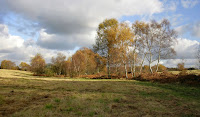I think I've already mentioned the beauty of the foreground shadow in pushing back the horizon. Another way to achieve the same effect is to paint in a dark cloud(s) overhead.
An often made error when painting shadow is forgetting to maintain your tonal values. It's so easy to use the same well of paint for all your shadows, with the result that distant shadows dry as dark as your foreground shadows. Adding water will lessen the strength, but wouldn't adding a cool or warm colour depending where you put the shadow look so much better.
 In the photo on the right you will see that the shadow of the line of ferns is by far the darkest. Note the horizontal line of shadow running from the ferns to the left side. You don't need to start with your darkest tone at the very bottom. Any darker or warmer object or line near to the bottom of your picture (your foreground) will help you achieve a sense of depth.
In the photo on the right you will see that the shadow of the line of ferns is by far the darkest. Note the horizontal line of shadow running from the ferns to the left side. You don't need to start with your darkest tone at the very bottom. Any darker or warmer object or line near to the bottom of your picture (your foreground) will help you achieve a sense of depth.One last point: photos don't always show shadows as being lighter as they recede. The camera is infinitely better at capturing a scene than we are, so we can be sure that they probably do. It's just that we aren't able to grasp such a small shift in the tone. To be certain your viewers do see and appreciate this change in your painting it might be necessary to exaggerate the tone in your shadows.
ps Thanks for pointing out the typo, John. I've corrected it now (and given this post a slight rewrite). I can't see for looking sometimes, so if you see any more please let me know.
A typo? "the to the bottom (your foreground)"
ReplyDelete